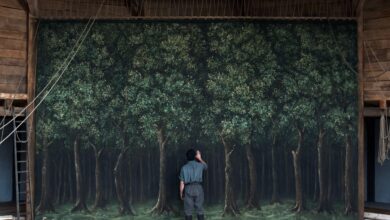Author Q&A with Jeff Guinn

Some readers may recognize Jeff Guinn as the author of “The Autobiography of Santa Claus” and two popular Santa-related sequels, or as the author of “The Last Gunfight: The Real Story of the Shootout at the O.K. Corral,” “Manson: The Life and Times of Charles Manson” or “Go Down Together: The True, Untold Story of Bonnie and Clyde.”
Now he has given readers another opportunity to learn his name, this time as the author of a new series of Western novels beginning with “Glorious,” newly out in stores.
During a book tour visit to the Quail Springs Barnes & Noble in Oklahoma City, Guinn sat down for an interview with The Oklahoman. This is an edited transcript of that interview:
Q: In what way is a book tour different when the book is fiction instead of nonfiction?
A: My last several books have been nonfiction for Simon & Schuster. And the last couple made the New York Times list. When you have a nonfiction book people come out because they’re interested in the subject. With fiction, people come out if they feel like they have some connection with the author or the series. I was told when you have the first book with a series, don’t expect a big turnout.
Q: “The Last Gunfight” tells about events in Tombstone, in southern Arizona, and “Glorious” takes place in central Arizona. Did “Glorious” spring out of “The Last Gunfight”?
boldA: “Glorious” was almost accidental. I had written “The Last Gunfight” and it got a good reception, which I’m glad about. In all of my books, I am trying to capture an era in American history. I got a call from the Ford County Historical Society in Dodge City. They wanted to know if I would come up and do a program for them about Wyatt Earp in Dodge. Of course I would — they’d been so good to me when I was working on the book. I drove up. To go from Forth Worth to Dodge City, basically you don’t have to worry about steering. I was just starting to drive and my phone rang. It was Ivan Held, who is president at Putnam. Ivan said he’d read “The Last Gunfight.” He thought that there was a good series to be written — historical fiction involving the frontier — and wondered if I would be interested in writing one. I said, “I have about 12 hours to drive, let me think about it while I drive, and if I think of something I’ll call you back.” By the time I got to Dodge City, I had already figured some things out that I’d like to do in a Western fiction series, so that’s how I came to write “Glorious” and at least two other books in the adventures of Cash McLendon. It has been fun!
Q: Did you go to the area where “Glorious” takes place?
A:boldEverything you read in the book, pretty much, I tried myself so I could write about it accurately. I think if you ask people to spend $27 for a book, let alone put in the hours they need to read it, then they deserve to know that, if they’re reading historical fiction, it’s accurate. If there’s a golden age on the American frontier, it’s about a 10-year period: 1872 to 1882. After 1882, really, everything’s getting pretty civilized and by 1890 the government is saying there is no more frontier to settle. Around 1872, parts of Arizona Territory were just opening up to prospecting and mining. The Apache were being driven to the southeast part of the territory — Cochise, the Chiricahua — and for the first time prospectors were getting to look for silver in the Pinal Mountains. I wanted to set this book in some little, tiny, startup town to show how people would gather trying to find silver, and what would happen. So I basically got in my car and drove all over until I found the exact place I described in the book, and by golly, I got a hammer and I went up and tried to do silver prospecting, which is a lot harder than it seems. When you read about Cash McLendon falling down the side of a hill, bumping into a saguaro cactus, that was me. I sure didn’t find any silver but I definitely found how hard it is looking for it.
Q: As I was reading your book, I was thinking “This is authentic.” Your descriptions of the coach ride, the coach stops, the food they ate … it rang true.
A: The best historical fiction lets the reader be in that time and place. People read fiction to put themselves in a different place, and that’s what I hoped to do. I call this a nontraditional-traditional Western, because you’ve got your gunplay, there are Indians involved, there is a big shoot-out at the end, but I’m trying to write these things more as they really happened. In the West, there wasn’t a gunfight in Main Street at high noon every day — you didn’t have 20,000 Indians come roaring over the rise — and I didn’t want a protagonist who could outdraw, outshoot and outfight anybody. I wanted a real person. That is why I tried to go out and do these things, so I could describe them accurately. And I also wanted to make sure, for people who love “real Westerns,” that if we have somebody shooting a gun, it’s the right kind of gun. Hopefully every detail you read in the book is not only entertaining but accurate.
Q: One of the characters in your book is Ike Clanton. Is he THE Ike Clanton?
A: That’s him. The Clantons came to Arizona Territory from California right about this time, and one of the things I very much enjoyed about Ike Clanton is he was so stupid in real life, and so crooked, there were few bad things he hadn’t tried and fewer he wouldn’t try, and so he’s a very protean sort of villain. I wanted to give the people who say, ‘I never read Western fiction, I only read real history,’ a reason to try this book, too. In fact, Ike and his family were pretty much where I put them, they looked like I make them look. Ike will be making a reappearance in the third book in the series. He’s a good character to follow, just as dumb and belligerent as in real life. Throughout the series, not only are the places real, but some of the characters are real.
Q: Your protagonist, Cash McLendon, comes from St. Louis.
A: In 1872, and for years before that, St.Louis was sort of the western edge of civilization in America. When you went west and ended up on the coast, there were a few good-size cities there, but everything in between was a big mystery to a lot of Americans. They would go there thinking they’d have opportunities, and they had no idea what it would be like. I wanted to start McLendon out in civilization so he would have to learn a completely new way of life when he gets out to the frontier. I love historical fiction, I love Western fiction, but all too often, an author establishes a character in one specific place and stays there. In one book, the rustlers will come through, in another book the Indians, and what I wanted in the books was to bring readers on a tour of the whole American frontier. So I needed to have a protagonist who would have to move a lot. I didn’t want him moving for the old cliche — accused of a crime he didn’t commit and having to stay one step ahead of the law. So I had to give him a reason to run, which I did: He’s fleeing from a vengeful father-in-law who has sent a really scary killer after him. And he needed a reason to go out there, so he’s trying to reunite with a girl he treated badly in St. Louis. The great fun of this is I drive around looking, and if I find someplace interesting, maybe I’ll put the story there.
Source link




